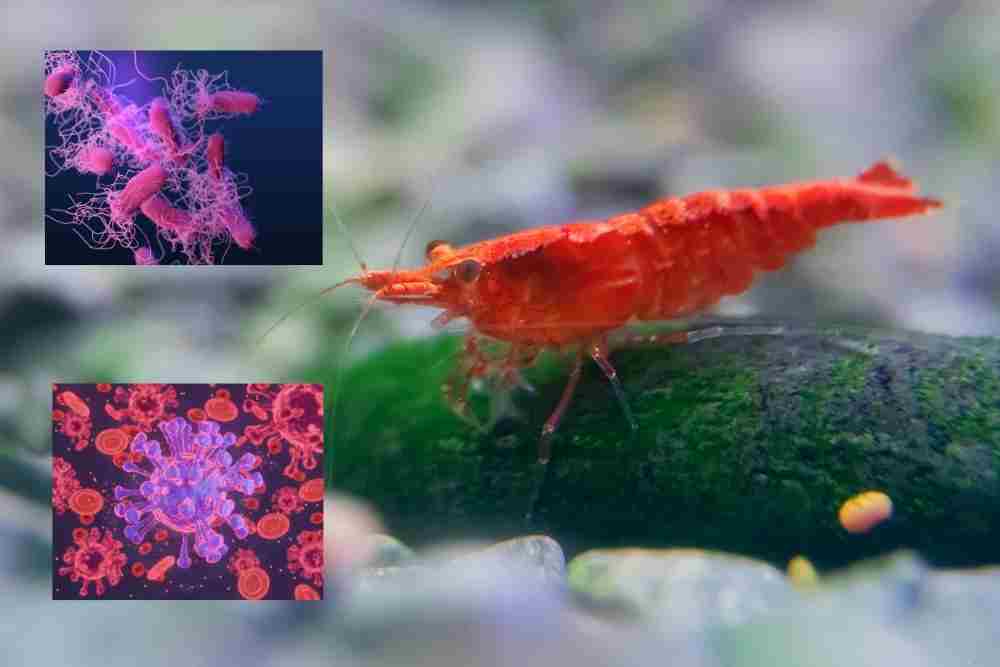Cherry shrimp diseases are a common problem for aquarists. Some of the most common diseases are white spots, blackleg, and redleg.
Cherry shrimp are a popular commercial shrimp and are often fed high concentrations of feed that include ingredients like cherry pits. Unfortunately, cherry shrimp are susceptible to a number of diseases, including velvet worm disease, red spot disease, and white spot disease.
Cherry shrimp disease is caused by different parasites and bacteria. A good way to prevent cherry shrimp diseases is to keep a clean tank and get rid of any sick or injured shrimp.

Causes of Cherry Shrimp Diseases
Cherry shrimp diseases are caused by a variety of parasites, some of which can be fatal to these shrimp.
Parasites can damage the shrimp’s immune system, causing them to become infected with other organisms that can also be deadly.
Cherry shrimp diseases are typically spread through contact with water or feces that contains parasites, and can also be passed on through sexual contact.
Proper care for these shrimp is important in order to help prevent them from becoming infected with any diseases.
It is important to be aware of the potential diseases that can affect cherry shrimp. Some diseases are caused by parasites, bacteria, or fungi, while others are the result of environmental stresses.
What is cherry shrimp and what do they look like
Cherry shrimp are a type of crustacean that belongs to the family Pandalidae. These shrimp can be found in warm waters all around the world from the Gulf of Mexico to Japan.
Cherry shrimp are very small and have a pink, red, or purple shell. They have two antennae and three pairs of legs.
Cherry shrimp is a type of shrimp found in the Indo-Pacific region. They are small, red, and have a sweet flavor. Cherry shrimp are used as food for humans, but they can also be farmed.
What Are The Most Common Diseases of Cherry Shrimp
- Diseases are a common problem for shrimp, as they are increasingly susceptible to them.
- The most common diseases of cherry shrimp are bacterial infections, such as Mycoplasma and Chlamydophila.
- Viruses also frequently cause disease in shrimp, including the herpes virus and the Newcastle disease virus.
- Parasitic diseases can afflict shrimp, including nematodes and cestodes.
- Cherry shrimp also suffer from nutritional deficiencies and environmental issues, which can lead to diseases.
- Knowing the signs of disease and treating it promptly is essential for keeping your shrimp healthy and productive!
What are the Signs that Your Shrimp May be Sick
- If you notice any of the following signs in your shrimp, it may mean they are sick:
-Shrimp that are not swimming or moving around as much as usual
-Shrimp that seem to be bloated or have a distended abdomen
-Shrimp that have lesions or red spots on their body - If your shrimp shows any of these symptoms, it is important to take them to a vet immediately for diagnosis and treatment.
- Keep an eye out for changes in your shrimp’s behavior – if they start being less active, staying in one spot, or hiding away from the light, it may be time to get them checked out by a vet.
Prevention of Cherry Shrimp Diseases
Cherry shrimp diseases are a common problem in aquaponic systems. The disease can cause decreased growth and food production, as well as the death of the shrimp. There are a few things you can do to prevent cherry shrimp diseases:
- Keep your water clean: Remove any large debris, leaves, or flowers floating in the water and make sure the water is always flowing properly.
- Make sure to regularly check the water quality and filter it as needed. Remove debris with a gravel cleaner or by hand if necessary.
- Vaccinate your shrimp: Immunize your shrimp against common diseases using a commercially available vaccine or vaccine preparation made specifically for aquaponics.
- Feed them healthy food: Feed your Cherry Shrimp high quality feed that consists of both protein and snacks.
Treatment for Cherry Shrimp Diseases
There are several treatments available for cherry shrimp diseases. These include antibiotics, growth regulators, and antiparasitic medications.
Antibiotics can be used to treat infections caused by bacteria, while growth regulators can help speed the healing of injuries inflicted by parasites.
Antiparasitic medications can be used to fight off parasites that may be causing the health of the shrimp to decline.
Cherry shrimp diseases can be a serious problem for aquarists, as these shrimp are popular for both home and commercial aquariums.
There are several different cherry shrimp diseases that can affect these creatures, so it is important to know how to treat them if they do occur.
The most common cherry shrimp disease is white spot syndrome, which is caused by the bacterium Serratia marcescens. This pathogen causes lesions on the body of the shrimp, and can eventually kill them. Treatment typically involves antibiotics and/or heat treatments to kill the bacteria.
Other cherry shrimp diseases that can affect these creatures include black shuck syndrome, red-eye syndrome, and cryptocaryon virus. Each of these conditions requires specific treatment methods that should be administered by an experienced aquarist.
Final Words
Cherry shrimp diseases are caused by a variety of organisms, most commonly bacteria and fungus. These diseases can cause serious damage to the shrimp’s body, including loss of pigment, stunted growth, and even death. Fortunately, there are several ways to prevent cherry shrimp diseases from taking hold in your aquaculture.